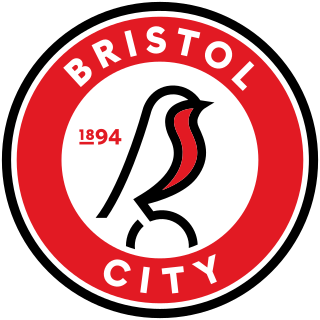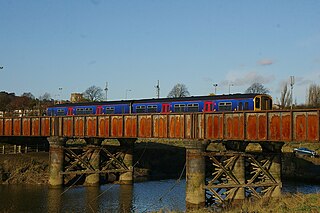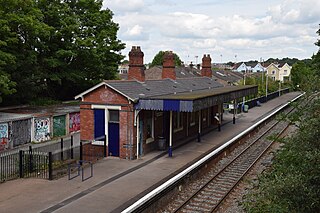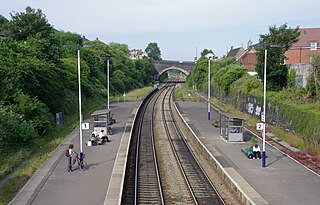
Bristol City Football Club is a professional association football club based in Bristol, England. The team compete in the EFL Championship, the second level of the English football league system.

Bristol Parkway, on the South Wales Main Line, serves the villages of Stoke Gifford and Harry Stoke in South Gloucestershire, England. Despite its name, it is located in Gloucestershire rather than Bristol itself. It is 112 miles (180 km) from London Paddington. The station was opened in 1972 by British Rail. It is the third-most heavily used station in the West of England local authority area, after Bristol Temple Meads and Bath Spa. There are four platforms, and a well-equipped waiting area. The station is managed by Great Western Railway, who provide most of the trains at the station, with CrossCountry providing the rest.

Avon was a non-metropolitan and ceremonial county in the west of England that existed between 1974 and 1996. The county was named after the River Avon, which flows through the area. It was formed from the county boroughs of Bristol and Bath, together with parts of the administrative counties of Gloucestershire and Somerset.

The Severn Beach line is a local railway line in Bristol and Gloucestershire, England, which runs from Bristol Temple Meads to Severn Beach, and used to extend to Pilning. The first sections of the line were opened in 1863 as part of the Bristol Port Railway and Pier; the section through Bristol was opened in 1875 as the Clifton Extension Railway.

Patchway railway station is on the South Wales Main Line, serving the town of Patchway and village of Stoke Gifford in South Gloucestershire, England. It is 6 miles (10 km) from Bristol Temple Meads. Its three letter station code is PWY. It is managed by Great Western Railway, who provide all train services at the station; there is generally a train every hour in each direction between Cardiff Central and Taunton.

Yatton railway station, on the Bristol to Exeter line, is in the village of Yatton in North Somerset, England. It is 12 miles (19 km) west of Bristol Temple Meads railway station, and 130 miles (209 km) from London Paddington. Its three-letter station code is YAT. It was opened in 1841 by the Bristol and Exeter Railway, and served as a junction station for trains to Clevedon and Cheddar, but these lines closed in the 1960s. The station, which has two platforms, is managed by Great Western Railway, the seventh company to be responsible for the station, and the third franchise since privatisation in 1997. They provide all train services at the station, mainly hourly services between Bristol Parkway and Weston-super-Mare, and between Cardiff Central and Taunton.

Nailsea and Backwell railway station, on the Bristol to Exeter line, is in the village of Backwell, close to the town of Nailsea in North Somerset, England. It is 8 miles (13 km) west of Bristol Temple Meads railway station, and 126 miles (203 km) from London Paddington. The station, opened in 1841 by the Bristol and Exeter Railway, has two platforms but little in the way of facilities. It is managed by Great Western Railway, the seventh company to be responsible for the station, and the third franchise since privatisation in 1997. The company provides all train services at the station, mainly hourly services between Bristol Parkway and Weston-super-Mare, and between Cardiff Central and Taunton.

Montpelier railway station is on the Severn Beach Line and serves the district of Montpelier in Bristol, England. It is 2.85 miles (4.59 km) from Bristol Temple Meads. Its three letter station code is MTP. The station has a single platform, serving trains in both directions. As of 2015 it is managed by Great Western Railway, which is the third franchise to be responsible for the station since privatisation in 1997. They provide all train services at the station, mainly a train every 30 minutes in each direction.

Clifton Down railway station is on the Severn Beach line and serves the district of Clifton in Bristol, England. It is 3.9 miles (6.3 km) from Bristol Temple Meads. Its three letter station code is CFN. The station has two platforms, each serving trains in one direction only. As of 2015 it is managed by Great Western Railway, which is the third franchise to be responsible for the station since privatisation in 1997. They provide all train services at the station, mainly a train every 30 minutes in each direction.

Redland railway station is on the Severn Beach Line and serves the districts of Cotham and Redland in Bristol, England. It is 3.3 miles (5.3 km) from Bristol Temple Meads. Its three letter station code is RDA. As of 2015 it is managed by Great Western Railway, which is the third franchise to be responsible for the station since privatisation in 1997. They provide all train services at the station, mainly a train every 30 minutes in each direction.

Bedminster railway station is on the Bristol to Exeter line and serves the districts of Bedminster and Windmill Hill in Bristol, south-west England. It is 0.9 miles (1.4 km) to the west of Bristol Temple Meads, and 119 miles (192 km) from London Paddington. Its three letter station code is BMT. It was opened in 1871 by the Bristol and Exeter Railway, was resited slightly further to the west in 1884 and was rebuilt in 1932. The station, which has three through-lines and two island platforms, but minimal facilities, is managed by Great Western Railway who operates all train services that serve the station, mainly an hourly service between Bristol Parkway and Weston-super-Mare.

Parson Street railway station serves the western end of Bedminster in Bristol, England. It also serves other surrounding suburbs including Bishopsworth, Ashton Vale and Ashton Gate, along with Bristol City FC. It is 2 miles (3.2 km) from Bristol Temple Meads, and 120 miles (193 km) from London Paddington. Its three letter station code is PSN. It was opened in 1927 by the Great Western Railway, and was rebuilt in 1933. The station, which has two through-lines and two platforms, plus one freight line for traffic on the Portishead Branch Line, has minimal facilities. As of 2020, it is managed by Great Western Railway, which is the sixth company to be responsible for the station, and the third franchise since privatisation in 1997. They provide all train services at the station, mainly an hourly service between Bristol Parkway and Weston-super-Mare.

Flax Bourton railway station was a railway station on the Bristol to Exeter line, 5 miles 49 chains (9.03 km) from Bristol Temple Meads, serving the village of Flax Bourton in North Somerset. It opened in 1860, and was closed by the Beeching Axe in 1964.
The geographical term Severnside refers to an area adjoining or straddling the River Severn or its estuary in Great Britain.

South Bristol Community Hospital is a community hospital in the Hengrove area of Bristol, England, on the site of the former Whitchurch Airport. It opened in March 2012. It is managed by the University Hospitals Bristol and Weston NHS Foundation Trust.

MetroWest, formerly known as the Greater Bristol Metro, is a project to improve the rail services in Bristol, England, and the surrounding region. It was first proposed at First Great Western's Stakeholder Event in March 2008. The aim of the project is to develop half-hourly services through central Bristol which will also serve the surrounding West of England region. Transport campaigning groups Friends of Suburban Bristol Railways (FoSBR) and Transport for Greater Bristol are actively supporting the proposal, as are the three unitary authorities under the West of England Combined Authority and North Somerset Council.

The Bristol to Exeter line is a major branch of the Great Western Main Line in the West of England and runs from Bristol, to Exeter, from where it continues as the Exeter to Plymouth line. It was one of the principal routes of the pre-1948 Great Western Railway which were subsequently taken over by the Western Region of British Railways and are now part of the Network Rail system.
Community rail in Britain is the support of railway lines and stations by local organisations, usually through community rail partnerships (CRPs) comprising railway operators, local councils, and other community organisations, and rail user groups (RUGs). Community railways are managed to fit local circumstances recognising the need to increase revenue, reduce costs, increase community involvement and support social and economic development. The Community Rail Network (CRN), formerly known as the Association of Community Rail Partnerships (ACoRP), supports its fifty or so member CRPs and also offers assistance to voluntary station friends groups that support their local stations through the station adoption scheme. Since 2005 the Department for Transport has formally designated a number of railway lines as community rail schemes in order to recognise the need for different, more appropriate standards than are applied to main line railway routes, and therefore make them more cost effective.
Bristol Rail Campaign is a Bristol-based campaign group, calling for better rail transport in the Bristol area.

Winterbourne railway station served the South Gloucestershire village of Winterbourne, England, from 1903 to 1963.

















